Gooseberry jam recipe
This gooseberry jam recipe has many of the phytochemicals that make for greater well-being. The downside, of course, is that there is quite a lot of sugar; but one teaspoon per day will not do too much damage when enjoyed on bread baked using 100-percent wholemeal flour.
Turning seasonal fruit into jams using as little sugar as possible is an art in itself; the pectin in lemon-pips helps.
Throughout the summer it has been wonderful watching the plants develop, knowing there is a sweet-harvest ahead.
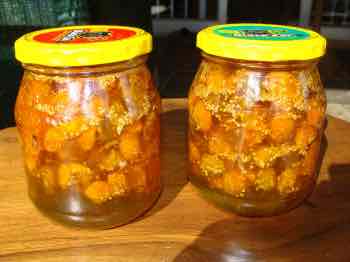
- Bernard Preston homepage
- Bread
- Gooseberry Jam Recipe
This page was last updated on 3rd January, 2022.
Making jam is a way of preserving your fruit for greater nourishment the whole year round for the phytochemicals. The cape-gooseberry season does last several months, but this way you can enjoy them throughout the seasons.
Pick the fruit and enlist the help of any willing children or grand-kids; often the best gooseberries will be found on the ground under the bush. This is what takes the time.
- Bernard Preston homepage
- Bread
- Gooseberry Jam Recipe
Remove the cape, select only the choice gooseberries and then wash them; obviously the riper, the sweeter the jam.
If you have hens, by the way, they will go crazy over the suspect gooseberries; that way you can be sure that any worms will not infect next year's crop. Allow the birds to wander about the bushes once you are done with reaping the fruit.
Just like us they desperately need the carotenes for their egg-yolks, and especially the lutein for their sharp eyes. Some can be converted in the body into vitamin A. They are strongly anti-oxidant but taken as supplements[1] will increase the risk of lung tumours; as always, let your food be your medicine. Hippocrates knew what he was talking about.
To some gooseberries clearly belong on the list of invasive alien-species but they provide enormous benefit to both humans and birds.
The link below discusses the different grades of invasive-species and some of the contentions about these plants and animals.
Gooseberry jam recipe
Gooseberry jam recipe means quite a lot of time picking the fruit; enlist the whole family when it comes to reaping.
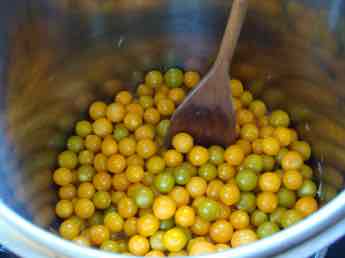
Weigh when rinsed and then cook the fruit for about 15-minutes with the juice of one large, lemon for each pound (450 g) of fruit.
What is the first-thing you do when moving into a new home? Plant a lemon tree, of course.
If you want to improve the nutrition of your gooseberry jam recipe, then use the lemon pulp too along with the juice, because that's where more than half of the nutrients are to be found.
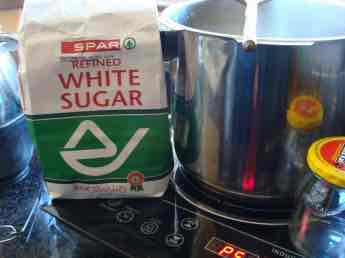
Add an equal weight of sugar for each pound of the fruit.
In case you were wondering, a heaped teaspoon of this gooseberry jam recipe contains about 7.5g of sugar; a slice of bread has about 18g of starch.
If you are healthy, aim for 150g of starch or less, but much stricter if you are obese or diabetic. It is the refined carbohydrates like sugar that make us fat. That would mean for many that commercial bread with this gooseberry jam recipe is off-limits. Just one slice contains about half of your daily ration.
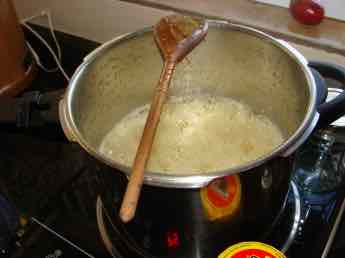
Boil fast on high heat, mindfully not allowing the mixture to bubble over. Watch it carefully as it tends to foam at different-stages.
Here I am using an induction-stove; it is quicker, and uses less energy than a normal electric hob, or gas.
Finding the setting-point is a crucial art in jam and jelly-making. It takes experience, but dripping a few drops onto a plate, and then placing it in the freezer for a couple of minutes helps. If the surface crinkles when you push it gently with a finger, then the mixture has reached the gel temperature.
Boil for too short a time, and you will have very runny jam.
Go too long and it will turn to toffee.
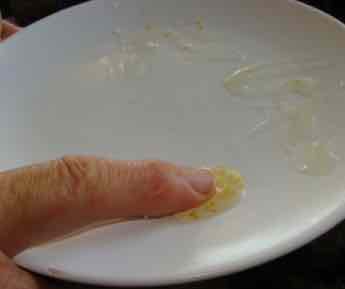
If you can acquire a wide-mouthed funnel, they are wonderful for the jam and jelly-maker. This one has a throat of about one inch. Then the fruit does not block up when bottling.
Put a fork down the funnel into your glass-jars; it helps prevent them from cracking due to the hot jam.
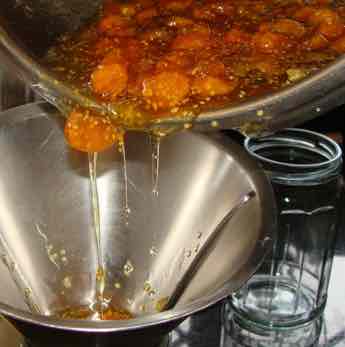
Whether on bread with butter, or even delicious with ice cream, your preserve has many spots in the food-lover's heart.
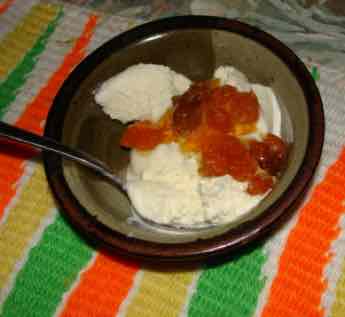
Bottles will make perfect Christmas presents; just print a pretty label on your computer, from your kitchen, or some such thing. You can be assured they will never make white-elephants.
Choice foods
Jam making is really about preserving some of our choice foods for year-round enjoyment. Mostly we eat too little fruit, rich in the phytochemicals that help prevent tumours; jams, jellies and preserves are one solution.
Whilst it is true sugar has been added, about one-teaspoon per helping, in the context of low GI bread and butter, it is not likely to produce a blood glucose spike, with the ensuing insulin response; unless you are diabetic. Then you absolutely must take a short walk after a starchy meal.
Even more so, if you enjoy your bread and gooseberry jam recipe with a summer salad, you need have no concerns about raised blood glucose.
Easy lunch recipes
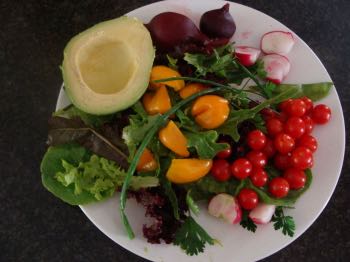
Easy lunch recipes do take a little longer to throw together than a slice of commercial bread with peanut-butter and jelly, but the flavours are sublime.
Just fill that half avocado with this homemade healthy hummus recipe, and a side-dish of bread and the fruit of your labours, read gooseberry jam recipe, and you have a very filling and nutritious lunch.
Am I a bit of a nut? Yes, maybe, you understand I do not want to get nasty tumours like half my family has suffered from; and this tastes unbelievably good in any case.
Our various homemade artisan breads taste so good, especially the sourdough, that I find I am using less jams; that fits in with our philosophy of keeping away from all refined-starches like sugar. Often we just swallow the scrumptious fruit straight from the bushes.
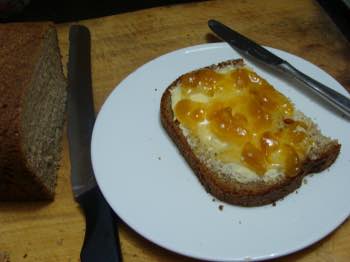
I have a dream
I dream of an NGO initiating small farmers into growing gooseberries and turning them into jam. It is labour-intensive work, but then nearly 50 percent of South Africans are unemployed. Would it help shift a few from the melancholy of the dole to meaningful employment?
I dreamed of a two hectare plot with a small home, solar-panels and an inverter. One half of the land would be enough plants to keep folk busy with this gooseberry jam recipe. It is the very best and buyers would offer their souls in exchange for fruit made with as little sugar as possible.
The kids would not be forced into child-labour, but encouraged to help with picking and shelling the fruit.
Finally there would be food on the table, and money for school-uniforms and shoes.
Who is going to do it? Cooking would be done perhaps on solar induction stoves, or could invasive aliens like wattles be used in wood-stoves for heating?
Useful links
- Roasted butternut squash recipe, another great source of yellow carotenes.
- Phytochemical Foods
- How to make mulberry jam. Web: https://tinyurl.com/5dmesmjp
- Induction cooktop stoves
Bernard Preston
Bernard Preston is a self-confessed health nut; it does cost quite a few hours and energy, but you save it many times over in virtually zero visits to the doctor and pharmacist.
A life without medication[2] is another blessing for those who take their food seriously. Not that there is not a place for drugs but the antioxidants in the phytochemicals mean that health-nuts usually have normal cholesterol and blood pressure; heart disease is rare and they have squeaky-clean capillaries.
It is purely anecdotal but I went for some tests this week; just to confirm what I already knew. My cholesterol is 4.7 (182) and BP 118/80; that's not too shabby for someone of 73.
I alluded above to the fact that hens love yellow foods; it is the carotenes in gooseberries and butternut, corn and papaya that gives free-range birds bright orange yolks.
Their second-most favourite food is greens like kale and broccoli; they contain the lutein that protects our eyes against macular degeneration. That is another carotene.
My optician was astonished recently and asked if I eat a lot of greens; he said there was absolutely no sign of cataracts or macular-degeneration which is apparently quite rare when over seventy.
Are these the ravings of a lunatic? See what the Linus Pauling institute has to say about carotenoids[1].
- Carotenoids at the Linus Pauling institute.
- Life without medication. Web: https://tinyurl.com/3ntuxw44
- Berries fight malignant tumours
When browsing use right click and "Open Link in New Tab" or you may get a bad gateway signal.
Newsletter
Our newsletter is entitled "create a cyan zone" at your home, preserving both yourself and Mother Earth for future generations; and the family too, of course. We promise not to spam you with daily emails promoting various products. You may get an occasional nudge to buy one of my books.
Here are the back issues.
- Lifestyle and ideal body weight
- What are ultra-processed foods?
- Investing in long-term health
- Diseases from plastic exposure
- Intensive lifestyle management for obesity has limited value
- A world largely devoid of Parkinson's Disease
- The impact of friendly bacteria in the tum on the prevention of cancer
- There's a hole in the bucket
- Everyone is talking about weight loss drugs
- Pull the sweet tooth
- If you suffer from heartburn plant a susu
- Refined maize meal and stunting
- Should agriculture and industry get priority for water and electricity?
- Nature is calling
- Mill your own flour
- Bake your own sourdough bread
- Microplastics from our water
- Alternative types of water storage
- Wear your clothes out
- Comfort foods
- Create a bee-friendly environment
- Go to bed slightly hungry
- Keep bees
- Blue zone folk are religious
- Reduce plastic waste
- Family is important
- What can go in compost?
- Grow broad beans for longevity
- Harvest and store sunshine
- Blue zone exercise
- Harvest and store your rainwater
- Create a cyan zone at your home
When browsing use right click and Open Link in New Tab, or you may get a bad gateway signal.
Did you find this page interesting? How about forwarding it to a friendly book or food junkie? Better still, a social media tick would help.
- Bernard Preston homepage
- Bread
- Gooseberry Jam Recipe
Address:
56 Groenekloof Rd,
Hilton, KZN
South Africa
Website:
https://www.bernard-preston.com